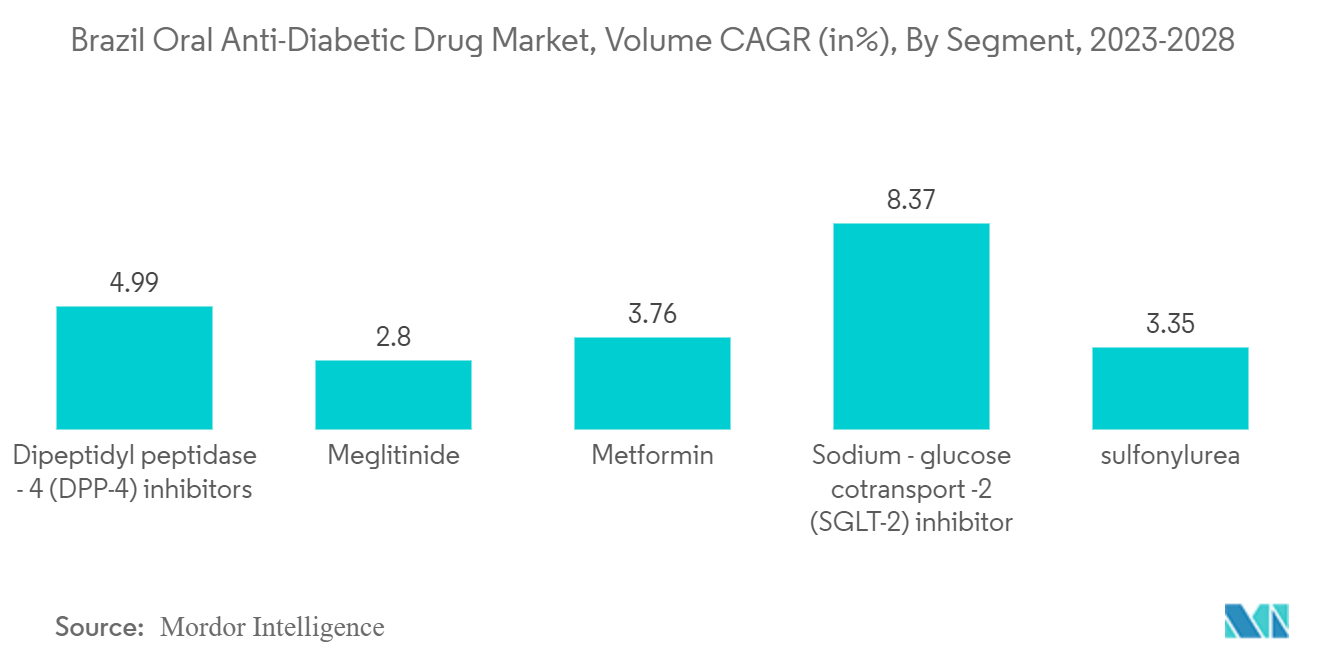Market Trends of Brazil Oral Anti-Diabetic Drug Industry
Sulfonylurea Segment Occupied the Highest Market Share in the Brazil Oral Anti-Diabetic Drugs Market in the current year.
Regarding revenue, the sulfonylurea segment is anticipated to lead the Brazil Oral Anti-Diabetic Drugs Market and post a CAGR of over 1% during the forecast year.
Sulfonylureas reduce glycated hemoglobin A1C (HbA1c) by 1% to 1.25% and have comparable effectiveness. Due to their low cost, second-generation sulfonylureas are among the most popular anti-diabetic drugs. Today, doctors seldom ever recommend first-generation sulfonylureas. Sulfonylureas are not recommended for older individuals and those with renal or hepatic impairment. Sulfonylureas can be used with any other oral diabetes medicine, except meglitinides (nateglinide and repaglinide), for Type 2 diabetes patients. to take anti-diabetic drugs to manage their blood sugar levels and prevent hypo and hyperglycemia. Oral anti-diabetic medications have higher acceptability than insulin, improving therapy adherence. They also have the advantages of easier control and cheaper cost. IDF asserts that several socioeconomic, demographic, environmental, and genetic factors, including urbanization, aging populations, declining levels of physical activity, and rising rates of overweight and obesity, are to blame for Brazil's Type 2 diabetes epidemic. In Brazil, diabetes is becoming more common among people of all ages. Due to its high incidence and associated rising cost burdens on individuals, healthcare systems, and governments, diabetes mellitus has drawn a lot of attention. The Brazilian government's many measures are anticipated to fuel the market's expansion. The government has cooperated with various private businesses to use its supply chain (production, distribution, and merchants) to guarantee affordable medicine pricing.
Sulfonylureas reduce glycated hemoglobin A1C (HbA1c) by 1% to 1.25% and have comparable effectiveness. Due to their low cost, second-generation sulfonylureas are among the most popular anti-diabetic drugs. Today, doctors seldom ever recommend first-generation sulfonylureas. Sulfonylureas are not recommended for older individuals and those with renal or hepatic impairment. Sulfonylureas can be used with any other oral diabetes medicine, except meglitinides (nateglinide and repaglinide), for type 2 diabetes patients. Therefore, the abovementioned factors are anticipated to expand the category during the forecast period.

The increasing Diabetes Population in Brazil is driving the market.
Diabetes is a severe health issue that presents one of the most incredible difficulties to Brazilian healthcare systems. The development of novel medications to provide diabetic patients with more treatment choices has been driven by the disease's increasing incidence, prevalence, and progressive nature. Some of the key prospects for the participants in the diabetes medications market include the introduction of several new products, expanding international research partnerships for technological progress, and raising public awareness of diabetes. The Brazilian government's many measures are anticipated to fuel the market's expansion. To ensure affordable medicine pricing, the Brazilian Federal Government collaborated with various private businesses to use their supply chain (production, distribution, and retailing).
The level of support for people with diabetes has been steadily rising under Brazil's public health system (Sistema nico de Sade; SUS). In Brazil, SUS continued to be the primary source for obtaining oral antidiabetic medications, funding more than 70% of them in the nation when taking into account Health Unit Pharmacies and Popular Pharmacies, demonstrating the significance of public pharmaceutical policies in ensuring the Brazilian population's access to medications and in lowering inequities in the nation. However, consumers' shift from SUS Health Units to Popular Pharmacies shows that Primary Health treatment's role in administering oral antidiabetic medications may be lessened, damaging the relationship and the continuity of treatment. The health system has to be reorganized due to the rise in chronic illnesses, which calls for investments in research, surveillance, NCD prevention, and promoting healthy lifestyles. The Brazilian Ministry of Health published the Strategic Action Plan to Tackle NCDs in Brazil, 2011-2022, which calls for expanding free access to medications and other health products. It also aims to monitor access to essential health services, including medicine, as a crucial part of NCD surveillance.
Therefore, the abovementioned factors are anticipated to expand the category during the forecast period.


